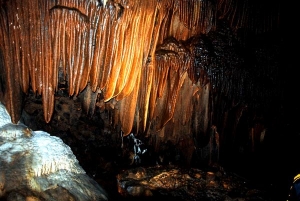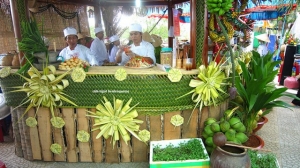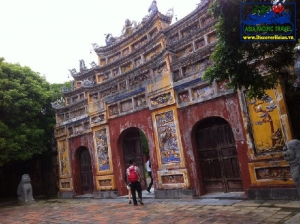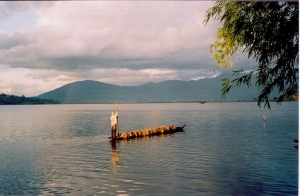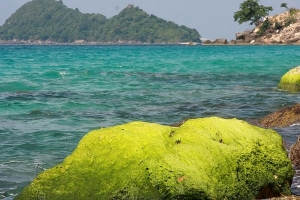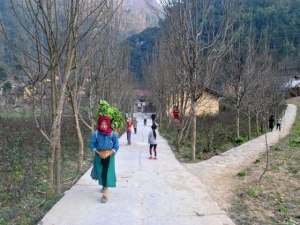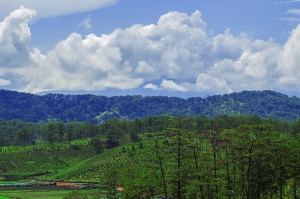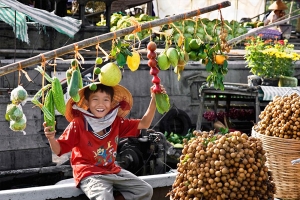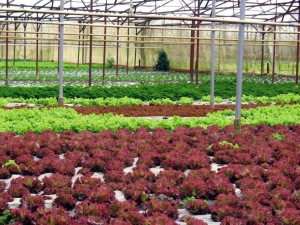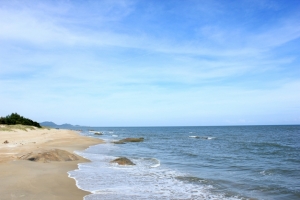
Asia Pacific Travel Team
New stalactite cave systems found in Ha Giang
Hang Duong Thanh, Deputy Chairman of the People's Committee of Quan Ba district, said the natural wonder was the most beautiful grotto in the province.
It's untouched beauty and splendid, transparent white stalactites are said to be stunning. Measuring from one to two metres, the stalactites take many strange forms.
Some look like giant stone lithophones, others resemble towers or flowers.
During a recent visit to the grotto, provincial Party Committee Secretary Trieu Tai Vinh said it will make an ideal tourist destination.
He said his committee will help raise awareness of residents in the area about the cave system and the geological values of the plateau.
Coconut festival 2015 will be held in Ben Tre
The Southern Coconut Cuisine Festival place from April 7 to 13 at Hoang Lam Statue Park will see the participation of tourism sites, restaurants, and kitchens from Ben Tre, other Mekong Delta provinces, HCM City and Dong Nai Province and the Ben Tre Women's Union.
There will be over 50 food-related stalls set up by nearly 30 companies and restaurants and others in the sector and 20 stalls set up by companies from Ben Tre and other delta provinces to introduce local tourism attractions.
Reopening more monuments restored in Hue
The Hue Monuments Conservation Centre, which manages the use and conservation of the city's monuments, said the Thai Binh Lau (Pavilion), Xung Khiem Ta (Pavilion), Du Khiem Ta (Pavilion) and Duyet Thi Duong royal theatre will open their gates to tourists.
Thai Binh Lau Pavilion, which includes a two-storey wooden house with unique architecture, sits inside the former Imperial Palace and once served the king's reading and relaxing needs.
The original pavilion was built in 1887 but its original wooden structure was ruined over the years. The restoration work took four years and cost VND24 billion (US$1.1 million).
Nearby in the palace is Duyet Thi Duong, one of the oldest theatres in Viet Nam that still claims its original structure. The recent restoration work focused on remodeling the interior, bring it back to its original design.
The theatre will now host performances of nha nhac (Hue royal court music), as it was originally intended for when it was built in 1826. A show would be held to entertain royalty and entertain guests.
Two other pavilions in the Khiem Lang Tomb vicinity are up and running. The tomb is the resting place for the Nguyen Dynasty's fourth king, Tu Duc, famous for his poems.
King Tu Duc built the mausoleum for himself, together with a manmade pond and hill. All the sights at the mausoleum have the word khiem (modest) in its name, apparently a reflection his character.
The renovated wooden pavilions emerge from the placid surface of the Luu Khiem pond. They are famous examples of the typical architecture of their time.
Built in 1864, Xung Khiem Ta pavilion was a place for the king to relax and write his poems. Du Khiem Ta pavilion served as a pier for sightseeing boats that might wish to go for a meander around the king's resting place.
The restoration of the pavilions cost VND27 billion ($1.25 million).
Legendary beauty of Lak lake
Surrounded by primeval forests, the lake is a popular eco-tourist site. It is also closely associated with the many legends of the local M’nong ethnic people.
It covers 500 ha and is about 500m above sea level. From afar, the lake looks like a soft silk strait adding to the charm of the central highlands mountain.
The lake is surrounded with primeval forests featuring a wide variety of flora and fauna species, many of them listed in the Red Book. A large number of tamed elephants live around the lake. The scene of mahouts riding elephants around the lake and on the streets or elephants swimming in the lake attracts lots of tourists.
Nguyen Manh Ha, a tourist from Hai Phong, said tourists to Lak lake are offered a variety of services. They can ride an elephant or row a wooden boat around the lake. They can also visit the villages of the M’Nong or go deep into the forests.
In addition to exploring the lake’s natural beauty, visitors to Lak lake can also discover the traditional culture of the M’Nong and their elephant taming work.
Three generations of Dam Nang Long’s family have involved in taming elephants and Long has the largest number of them in Lak lake. Long said the central highlanders in general and the M’Nong in particular love elephants very much and consider them a symbol of power and prosperity for their clans and families.
After being tamed, the elephants will go to the village and an admission ceremony will be held to welcome them. From then on they become new members of the family, and are named according to a member of the family. According to M’Nong tradition, the elephants share their love and have the right to the family’s property. They will be buried after they die, Long added.
Three generations of Dam Nang Long’s family have involved in taming elephants and Long has the largest number of them in Lak lake. Long said the central highlanders in general and the M’Nong in particular love elephants very much and consider them a symbol of power and prosperity for their clans and families
After being tamed, the elephants will go to the village and an admission ceremony will be held to welcome them. From then on they become new members of the family, and are named according to a member of the family. According to M’Nong tradition, the elephants share their love and have the right to the family’s property. They will be buried after they die, Long added.
Travel to Tho Chu apchipelago
The archipelago, however, has not been frequented by tourists despite its wild and natural beauties.
It is because Tho Chu is 220 kilometers from the mainland, a distance which is two to three times farther than other popular islands in the nation such as Co To, Bach Long Vi, Ly Son and Phu Quy.
To reach Tho Chu, visitors have to take a 16-hour boat trip which departs every five days. The boat stops over at Phu Quoc Island for one night.
Our first destination upon arrival at Tho Chu is the two milestones built to assert the nation’s sovereignty over the islands. One of the milestones was built in 1956 by the then South Viet Nam regime and the other was built in 1976 and recovered in 2003 by the Viet Nam Government.
Located nearby is Tho Chau temple which was opened in 2013 to commemorate 500 civilians who were abducted to Cambodia and then massacred by Khmer Rouge in May 1975, as well as the soldiers who died in that battlefield to protect the islands.
Aside from those historical places are stunning natural landscapes that make Tho Chu look like a giant painting.
It is hard to find anything which is more wonderful than riding a bicycle along the coastal road to watch the smaller islands around such as Xanh Island and Tu Island as well as flocks of terns flying over boats laden with fish, and then return to the Tho Chau Commune center through a path under the shades of trees, listen to birdsongs and enjoy the delicate scent of wild orchids in the air.
There are many beaches with white sand and blue sea around Tho Chu but the most beautiful and wildest one is the beach of Tu Island with its particular ecosystem that can hardly be found elsewhere.
The seashore with white sand is like a crescent moon, surrounded by coconut trees, heliotropium foertherianum, barringtonia asiatica, and the purely blue seawater, creating a small airtight gulf.
Another great scene is the stone layers that were created by water flows and winds for millions of years. Towards the forest are smooth stones in odd shapes, caves and semi-submersible rocks.
Reaching the depth of more than eight meters under the sea, we are attracted by seaweed, and schools of fish swimming among Montipora corals or gather around Acropora corals.
After snorkeling, we go fishing. The fishing activity at Tho Chu is different as we drop the line while the boat is sailing and do not use either fishhook or bait. To cat fish, we use nylon torn into small pieces and tie it to a 30-50-meter fishing line. While the boat is moving, the nylon bundle is used as prey to catch fish. As the fish bite the nylon and their teeth get stuck in the nylon bundle. That is how they are caught. What a new experience!
Lung Cam Tren village in Ha Giang
Local people have actively engaged in community tourism by upgrading their homes into visitor accommodation, growing more ornamental plants and removing breeding sites away from housing areas. Traditional cultural shows are now regularly performed for tourists.
The village welcomed at least 100 groups of foreign travellers last year.
Mua Sia Mua, a local resident, said his family earned an extra of 3-5 million VND each month from homestay services offered during the tourism seasons.
Meanwhile, the upgrading of local infrastructure - including roads, the water supply network and irrigation systems, alongside the building of community houses - have helped improve living standards and lure more visitors.
The local authority has encouraged the residents to grow high-yield crops and breed good-quality animals, enabling the commercialisation of livestock production and improved productivity.
Intensive farming of maize, soy beans and grass used in cattle breeding are among several effective agricultural models employed by the villagers.
The locals’ incomes have been improved further by the development of extra businesses, including traditional brocade weaving and metal forging.
Dong Van district is home to the spectacular Dong Van Stone Plateau, which was recognised as a member of the Global Network of National Geoparks (GGN) in 2010.
The plateau is 80 percent limestone and contains the fossils of thousands of species of prehistoric creatures, which roamed the region 400-600 million years ago.
Ha Giang has a great potential for developing tourism, like the plateau, and is seeing to become one of the country’s key tourist centres.
Bidoup National Park in Da Lat
Established in 2004, the park has its name combined from Bidoup Mountain, the highest mountain on Lam Vien Plateau, and Ba Mountain, the highest one in Da Lat City.
Early in the morning, a car of the park was dispatched to pick us up and then brought us all the way along 723 Pass, which to many people is the most beautiful pass in Viet Nam, to reach the park, located 50 kilometers away from Da Lat City in Da Nhim Commune, Lac Duong District at a height of 650-2,287 meters above sea level.

A guide named Ha Trai of K’Ho ethnic community took us for a tour around the park. Along the way we were told of plants and leaves which can all be used as medicine that Ha Trai had learned from elderly people, and precious trees which have been enlisted in the World’s Red Book of Threatened Species. The forest was so wild while the atmosphere was cool and pure, giving us relaxing and comfortable feeling.
After a while, we reached Thien Thai Waterfall, lying in the middle of the forest, streaming strongly and leaving thousands of white bubbles around.
Inside the pine forest of Bidoup Nui Ba National Park are villas for tourists to stay for the night or take a rest.

At night, we were attracted by cong chieng (gongs) and dance performances of young K’ho men and women, the irresistible fragrance of grilled meat and the smell of ruou can (wine drunk out of a jar through pipes).
The next morning, we took a tour to the “low forest” to watch wild orchids, mushrooms and moss as well as Pinus krempfii, or Krempf’s pine, a rare species of pine which only exists at the Bidoup Nui Ba National Park, according to the park’s director Le Van Huong.
Can Tho boosts tourism development
Ecotourism and river tourism in Can Tho and in the Mekong Delta have gradually lured a large number of domestic and international tourists.
The number of tourists to Can Tho has been increasing since the launch of flights between Can Tho and some regions in the country. In 2014, Can Tho welcomed more than 1.3 million tourist arrivals and tourism receipts reached over VND 1,100 billion.
In recent years, ecotourism spots in Phong Dien, a charming countryside with lush orchards, are always selected by tourists to Can Tho. Tourists feel more interesting when they start a boat trip from Ninh Kieu Wharf to Can Tho old market, Cai Rang floating market… to experience the beauty of the region and crowded moments of trading activities on the river.
According to Director of Tourism and Trade Promotion Center of Phong Dien District Vo Thanh Giup, the locality focuses on promoting tourism, improving the quality of tourist sites, building models of community tourism, responsible tourism to highlight Phong Dien tourism. Currently, My Khanh Tourist Village and Truc Lam Phuong Nam Zen Monastery are the among most popular tourist destinations.
Located in the heart of the Mekong Delta, with a dense system of rivers, canals and orchard laden with fruits, Can Tho has favourable conditions for development of ecotourism and river tourism. Deputy Director of Can Tho's Department of Culture, Sports and Tourism Le Minh Son informed thanks to the right investment, the city’s tourism achieved positive results in terms of development of typical tourism products, and tourism branding. In the coming time, Can Tho tourism will focus on investing in typical tourism products, upgrading Cai Rang floating market and effectively exploiting river tourism routes.
Vice Chairman of People's Committee of Can Tho City Le Van Tam emphasized the city’s tourism will create new tourism products as traditional art and cultural program of Khmer ethnic at Pothysomrom Pagoda in O Mon District; system of ancient houses, Tan Loc fruit festival in Thot Not District, etc, restore Bang Lang stork park, Pho Tho – Ba Bo flower village and organize fact-finding tours of farms.
Hong Nhung
Dalat's farms as sightseeing venues
Thanh Mau area in Ward 7 of Dalat City is where tourists can find popular strawberry gardens. People will have a chance to admire fruitful and beautiful gardens and enjoy fresh fruits. Some farms’ owners charge VND10,000 for entrance fee but some allow free entrance for guests to come and enjoy strawberry for free. This is a good chance for tourists to talk and watch these hospitable farmers at work.
Other interesting venues that tourists should head to are flower glass houses in three villages of Ha Dong, Van Thanh and Thai Phien.
Ha Dong flower village was established in 1975 by 35 households who came from Hanoi. The venue has original architecture of a northern village with garden, pond, and cattle cages. Van Thanh village is known as a kingdom of roses while Thai Phien is home to flowers originated from foreign countries like sword lily, hydrangea, and dianthus among others.
If tourists visit these locations early in the morning they can learn some gardening tips from farmers. Those who come at night time will admire a fantastic view of flower-heating cages that look like thousands of fireflies sparkling in the dark.
Travelers who wish to capture the best pictures of cabbage and potatoes gardens should follow a path leading to the peak of Langbiang Mountain. On both sides of the road are a vast area of flowers, vegetables and fruits.
Ho Tram - The place for relax weekend
The tourist site, about 12km from Vung Tau City, has a peaceful white soft sand beach with lots of sports and leisure activities. There is a poplar forest contributing to the romantic view of the site. Tourists can also try some local specialties, including Moc Nui noodles at the price of VND15,000 per bowl or grilled fish costing from VND10,000 to VND15,000 per dish and grilled deo snail with onion. Guests can order live seafood to cook to their favorite taste. They can boil, steam or grill seafood at the price of VND10,000 per portion.
There is an interesting venue nearby which tourists should spend some time to discover. That is Thien That, locally known as Monkey Pagoda, located at the foot of Ky Van Mountain in Phuoc Hai Commune, Long Dat District of Ba Ria-Vung Tau Province.
The pagoda has simple architecture but the statue of the Buddha sitting on a lotus base looks beautiful. There is a path on a side of the pagoda leading to Ky Van Mountain which is appealing to travelers thanks to numerous stones in unique shapes like dolphin, elephant and turtle.
There is also a stone looking like a snake holding a pearl in its mouth that represents prosperity or a huge stone similar to the Buddha’s head. Tourists might see a stone that looks like a bending elephant or an ancient bo tree with its roots sticking to stones.
The pagoda is also home to around 200 monkeys that usually gather and play together in the daytime. Tourists can give banana to these monkeys but they should pay attention to their belongings as these naughty animals might snatch them.


